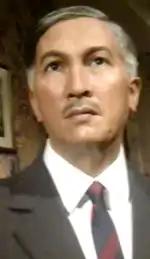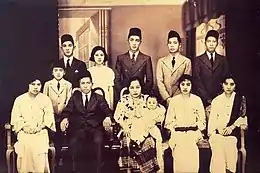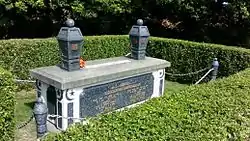Yusof Ishak
Yang Amat Berbahagia Tun Haji Yusof bin Ishak DUT (First Class), SMN, KStJ (Jawi: يوسف بن إسحاق; /ˈjʊsɒf bɪn ˈɪshɑːk/ YUUSS-off bin ISS-hahk; 12 August 1910 – 23 November 1970) was a Singaporean politician who was the first President of Singapore elected by the Parliament of Singapore, serving from 1965 to 1970. Yusof served for three terms in office before he died on 23 November 1970 due to heart failure. His portrait appears on the Singapore Portrait Series currency notes introduced in 1999.
Yusof Ishak DUT (First Class), SMN, KStJ | |
|---|---|
يوسف بن إسحاق | |
 | |
| 1st President of Singapore | |
| In office 9 August 1965 (retroactive) – 23 November 1970 | |
| Prime Minister | Lee Kuan Yew (1959–1990) |
| Preceded by | Yang di-Pertua Negera |
| Succeeded by | Benjamin Sheares |
| 1st Yang di-Pertuan Negara of Singapura | |
| In office 16 September 1963 – 9 August 1965 (retroactive) | |
| Monarch | Putra of Perlis |
| Prime Minister | Lee Kuan Yew |
| Preceded by | Yang di-Pertuan Negara |
| Succeeded by | Position abolished |
| 2nd Yang di-Pertuan Negara of Singapore | |
| In office 3 December 1959 – 16 September 1963 (retroactive) | |
| Monarch | Queen Elizabeth II |
| Prime Minister | Lee Kuan Yew |
| Preceded by | Sir William Goode |
| Succeeded by | Position abolished |
| Personal details | |
| Born | Yusof bin Ishak 12 August 1910 Terong, Taiping, Perak, Federated Malay States |
| Died | 23 November 1970 (aged 60) Singapore |
| Cause of death | Heart failure |
| Resting place | Kranji State Cemetery |
| Nationality | Singaporean |
| Spouse(s) | |
| Children |
|
| Alma mater | Victoria School Raffles Institution |
| Occupation | Politician |
| Profession | Journalist |
| Website | http://www.istana.gov.sg/ |
| Military service | |
| Allegiance | Straits Settlements (to 1946) Colony of Singapore (to 1959) Colony of Singapore (to 1963) Malaysia (to 1965) Singapore (to 1970) |
| Branch/service | Malaya Command (to 1957) Singapore Infantry Regiment (1957–1970) Singapore Armed Forces (1966–1970) |
| Years of service | 1929–1970 |
| Rank | |
| Unit | Singapore Infantry Regiment Singapore Armed Forces |
| Commands | Commander-in-Chief Colonel of the Regiment |
| Battles/wars | World War II (1939–1945) Part of (Cold War)
|
Before becoming head-of-state, Yusof was a well-known journalist and co-founded Utusan Melayu, which was in circulation till 9 October 2019. He started journalism after he graduated from Raffles Institution in 1929 and in 1932, he joined Warta Malaya, a well-known Malay newspaper company at that time. He left the company in 1938 and co-founded Utusan Melayu.[1]
Tun Yusof held many appointments within the Singaporean government. He served on the Film Appeal Committee from 1948 to 1950 and was also a member of both the Nature Reserves Committee and Malayanisation Commission for a year. In July 1959, he was appointed Chairman of the Public Service Commission, Singapore.[2] He was sworn on 3 December that year as Singapore's Yang di-Pertuan Negara (head of state) after the PAP won the first election held in Singapore after Singapore's self-governance.[3] Yusof then became the first President of Singapore after the country gained independence on 9 August 1965.
Biography
Early life

Born on 12 August 1910 in Kampung Padang Gajah, Terong, Taiping, Perak Darul Ridzuan, which was then part of the Federated Malay States (present day Malaysia), Yusof was the eldest son in a family of nine. He was of Minangkabau descent from his father's side while his mother was a Malay from the Langkat region in Indonesia.[4] His father, Ishak bin Ahmad, was also a civil servant and held the post of Acting Director of Fisheries, Straits Settlements and Federated Malay States.[5] His brother, Aziz Ishak, was a Malayan journalist and freedom fighter.
Yusof received his early education in a Malay school in Kuala Kurau, Perak and began his English studies in 1921 at King Edward VII School in Taiping, He was then admitted to Victoria Bridge School in 1923 when his father was posted to Singapore. In 1924, he was enrolled in Raffles Institution for his secondary education. During his time in Raffles Institution, he played various sports such as swimming, weight lifting, water-polo, boxing, hockey and cricket and had also represented the school in various sporting events. He was also part of the Singapore National Cadet Corps and was commissioned as the first ever cadet officer in the Corps due to his outstanding performance. Yusof received his Cambridge School Certificate with distinction in 1927, he was also awarded the Queen's Scholarship and decided to prolong his studies at Raffles Institution until 1929.[1]
Journalism career
After graduating from Raffles Institution in 1929, Yusof began his career as a journalist and went into partnership with two other friends to publish, Sportsman, a sports magazine devoted entirely to sports.[6] In 1932, Yusof joined Warta Malaya, a well-known newspaper during that time.[7] Warta Malaya was heavily influenced by developments in the Middle East and Yusof wanted a newspaper dedicated to Malay issues. He fulfilled his vision by establishing Utusan Melayu with several Malay leaders in Singapore in May 1939.[8]
During the Japanese Occupation of Singapore, Utusan Melayu had to stop circulation as machinery used to print the paper were requisitioned to publish the Japanese paper, Berita Malai. Yusof then moved back to Taiping and with the remaining money he had, he opened a provision shop and lived there until the war ended in 1945 and Utusan Melayu resumed publication. In 1957, Yusof moved to Kuala Lumpur and in February 1958, the headquarters of Utusan Melayu was also relocated to the city. During the post-war period, many Malays wanted independence of Malaya from the British and Yusof, fanned this fervour through his publications which resulted in the formation of the United Malay Nationalist Organisation (UMNO) in 1946. However, his democratic ideals were different from UMNO's vision of reestablishing the monarchy of Malaya. This resulted in rising tensions within the Utusan Melayu and in 1959, Yusof had sold his shares he had in the company and resigned as UMNO had bought over almost all of the shares of Utusan Melayu.[8]
Political career and presidency
Yusof held several appointments within the Singaporean government, he had served on the Film Appeal Committee from 1948 to 1950 and was also a member of both the Nature Reserves Committee and Malayanisation Commission for a year. After his resignation from Utusan Melayu, Yusof took the position of Chairman of the Public Service Commission of Singapore at the invitation of then Prime Minister Lee Kuan Yew.[9]
After PAP's victory from the 1959 Singaporean elections, Yusof was appointed as Yang di-Pertuan Negara and was sworn on 3 December 1959.[10] During his time as Yang di-Pertuan Negara, Singapore was divided by racial conflicts. Yusof actively promoted multiculturalism and reached out to people of all races to help restore trust and confidence after the 1964 racial riots.[11]
On 9 August 1965, Singapore was expelled from Malaysia and became an independent nation. The position of Yang di-Pertuan Negara was abolished and Yusof then became the first President of Singapore. As president, Yusof reached out to the people to reassure citizens astonished by Singapore's expulsion and continued to promote multiculturalism and a national identity within the country by visiting constituencies and reached out to different racial and religious groups.[12]
Yusof served for three terms in office before he died on 23 November 1970 due to heart failure.[13][14]
Family and personal life
Yusof is survived by his wife of 21 years, Puan Noor Aishah, and their three children, Orkid Kamariah, Imran, and Zuriana.[15] Puan Noor Aishah continued her husband's legacy of public service and was the first Asian to become president of the Singapore Girl Guides Association.[16] She and her now adult children were interviewed for the Channel NewsAsia documentary Daughters of Singapore, which screened in August 2015 as part of the SG50 celebrations and commemorated the spouses of Yusof Ishak and David Marshall, two pioneer leaders of Singapore.[17]
Yusof participated in several sports in his youth. He won the Aw Boon Par Cup for boxing in 1932, and was the national lightweight champion in weightlifting in 1933.[18] One of Yusof's hobbies was photography, and a collection of his photographs was donated to the National Archives of Singapore by his widow, Noor Aishah.[19] He also cultivated orchids,[20] and had the tennis courts at his residence on the Istana grounds, Sri Melati, converted into an orchid garden.[21] He performed the pilgrimage to Mecca in 1963.[22]
Legacy
The following institutions bear Yusof Ishak's name:
- Yusof Ishak Secondary School, opened by then-Prime Minister Lee Kuan Yew on 29 July 1966.[23]
- The Institute of Southeast Asian Studies (ISEAS) was officially renamed in August 2015 as the ISEAS–Yusof Ishak Institute on Yusof's 105th birthday, so its name will call to mind Yusof's "vision of equality, justice, harmony and strength amid diversity".[24]
- Yusof Ishak House in National University of Singapore's Kent Ridge campus along Lower Kent Ridge Road.[25]
- Masjid Yusof Ishak in Woodlands. The opening of this mosque in 2017 was officiated by the former president's widow, Puan Noor Aishah, and witnessed by guests including Prime Minister Lee Hsien Loong, Minister-in-charge of Muslim Affairs Yaacob Ibrahim, and Mufti Fatris Bakaram.[26]

Other memorials include:
- The current series of Singapore dollar notes, the portrait series issued from 1999 onwards, features Yusof Ishak.[27]
- In 2014, a wax figure of Yusof was unveiled at Madame Tussauds Singapore.[28]
- For the celebration of Singapore's 50th anniversary of independence (SG50) in 2015, Yusof Ishak was featured in all set of six SG50 Commemorative Notes for which he champions the caused of meritocracy, multi-racialism and modernization of Singapore.[29]
- Yusof is buried at Kranji State Cemetery, which is reserved for persons who have made a significant contribution to Singapore.
Honours
Honours of Singapore
_ribbon.png.webp) Darjah Utama Temasek, 1st Class[30]
Darjah Utama Temasek, 1st Class[30]
Foreign Honours
_-_SMN.svg.png.webp) Seri Maharaja Mangku Negara, Tun, (Malaysia), Grand Commander[31][32]
Seri Maharaja Mangku Negara, Tun, (Malaysia), Grand Commander[31][32] Pingat Kemahkotaan 1961 (Selangor)
Pingat Kemahkotaan 1961 (Selangor) Darjah Kerabat Laila Utama Yang Amat Dihormati (Brunei), 1st Class[31]
Darjah Kerabat Laila Utama Yang Amat Dihormati (Brunei), 1st Class[31]_ribbon.png.webp) Knight of the Order of St John[33]
Knight of the Order of St John[33]
See also
- Yusof Ishak Secondary School – a Secondary School in Singapore named in his honour.
- Masjid Yusof Ishak – a mosque located in Woodlands named in his honour.
References
- "Encik Yusof Ishak". Istana Singapore. Archived from the original on 11 April 2016. Retrieved 6 April 2016.
- "Yusof Head of State. The Straits Times, p. 1. Retrieved from NewspaperSG". 2 December 1959. Archived from the original on 5 April 2016. Retrieved 4 April 2016.
- Seet, K. K. (2000). The Istana (pp.88–89). Singapore: Times Editions. Call no.: RART 725.17095957 IST; Singapore rejoices. (4 December 1959). The Straits Times, p. 1
- "Istana – Former Presidents". The Istana. 13 December 2010. Archived from the original on 2 June 2011. Retrieved 23 April 2018.
- "The Singaporean Yusof Bin Ishak". The Singaporean. Archived from the original on 17 April 2016. Retrieved 6 April 2016.
- "Biography – Yusuf bin Ishak". Knowledge Net. Archived from the original on 18 April 2016. Retrieved 6 April 2016.
- "First issue of Warta Malaya (1930–1942) is published – Singapore History". History SG. Archived from the original on 28 April 2019. Retrieved 6 April 2016.
- Kuntom., Ainon (1973). Malay newspapers, 1876–1973: A historical survey of the literature (pp. 27–32). Archived from the original on 19 September 2020. Retrieved 6 April 2016.
- "Life and times of Yusof Ishak, Singapore's first president". The Straits Times. 18 August 2014. Archived from the original on 28 April 2016. Retrieved 6 April 2016.
- "Yusof Ishak: The man and his passions". AsiaOne. 25 August 2014. Archived from the original on 25 April 2016. Retrieved 6 April 2016.
- State of Singapore. Government Gazette. Extraordinary. (G.N. 62, p.1055). Singapore. 3 December 1959. Archived from the original on 19 September 2020. Retrieved 6 April 2016.
- "Straits Times: Iseas to be named after Yusof Ishak on Aug 12". Ministry of Foreign Affairs Singapore. Archived from the original on 15 April 2016. Retrieved 6 April 2016.
- "Cabinet pays last respects". The Straits Times, (Retrieved from NewspaperSG). 24 November 1970. Archived from the original on 20 April 2016. Retrieved 6 April 2016.
- "Yusof Ishak". www.roots.sg. National Heritage Board. Retrieved 8 November 2020.
- "Growing up in the Presidents' shadow". AsiaOne. Archived from the original on 24 March 2015.
- "History of Girl Guides Singapore" (PDF). Girl Guides Singapore. 2010. Archived from the original (PDF) on 8 March 2016. Retrieved 12 August 2019.
- "Changing Lives: Puan Dr Noor Aishah". Channel NewsAsia.
- "Son of S'pore first President: Yes, I taught PM Lee to ride a bike". The New Paper. 23 August 2014. Archived from the original on 11 August 2017. Retrieved 10 August 2017.
- Khoo, Kevin. "Yusof bin Ishak – The Republic of Singapore's First Head of State". National Archives of Singapore. Archived from the original on 4 January 2018. Retrieved 24 April 2018.
- "Yusof Ishak: The Man and his Passions". ifonlysingaporeans.blogspot.sg. Archived from the original on 28 May 2018. Retrieved 23 April 2018.
- "Singapore's history: The Istana". PropertyGuru Singapore. Archived from the original on 11 August 2017. Retrieved 10 August 2017.
- "Yusof bin Ishak – The Republic of Singapore's First Head of State". www.nas.gov.sg. Archives Online. Archived from the original on 3 August 2017. Retrieved 3 August 2017.
These pictures were personally taken by President Yusof Ishak during his pilgrimage to Mecca in 1963.
- "Our History". yusofishaksec.moe.edu.sg. Retrieved 8 November 2020.
Yusof Ishak Secondary School was established in 1965 as Jubilee Integrated Secondary School. It was an integrated school offering secondary education to an enrolment of 984 pupils and 37 teachers of two streams, in English and Malay. On 29 July 1966, then Prime Minister, Mr. Lee Kuan Yew declared open Yusof Ishak Secondary School (YISS) at Jubilee Road. We are the only school to be named after a President of our Republic.
- Nur Asyiqin Mohamad Salleh (12 August 2015). "Think tank renamed ISEAS-Yusof Ishak Institute, bearing name of Singapore's first president". The Straits Times. Retrieved 8 November 2020.
- "Facilities". nus.edu.sg. Retrieved 8 November 2020.
- "Yusof Ishak Mosque opens in Woodlands". Channel News Asia. 14 April 2017. Archived from the original on 25 April 2017. Retrieved 24 April 2017.
- "Circulation Currency: Notes". www.mas.gov.sg. Monetary Authority of Singapore. Retrieved 8 November 2020.
- "Yusof Ishak". Madame Tussauds Singapore. Retrieved 8 November 2020.
- "Set of six SG50 commemorative notes unveiled". TODAY. 19 August 2015. Archived from the original on 24 June 2016. Retrieved 29 June 2016.
- "Orders and Medals of Yusof Ishak". 31 July 1965. Archived from the original on 14 February 2016. Retrieved 24 April 2018.
- Omar, Marsita (2016). "Yusof bin Ishak". eresources.nlb.gov.sg. Infopedia / National Library Board, Singapore. Archived from the original on 6 May 2018. Retrieved 23 April 2018.
- "Senarai Penuh Penerima Darjah Kebesaran, Bintang dan Pingat Persekutuan Tahun 1963" (PDF). Archived (PDF) from the original on 3 March 2016. Retrieved 24 August 2018.
- "Yusof made Knight of St. John". Archived from the original on 10 February 2018. Retrieved 23 April 2018.
- Notes
| Library resources about Yusof Ishak |
- "Yusof Ishak". ISTANA Singapore : Office of the President of the Republic of Singapore, Government of Singapore. 28 April 2006. Archived from the original on 2 June 2011. Retrieved 20 September 2007.
| Wikimedia Commons has media related to Yusof bin Ishak. |
| Political offices | ||
|---|---|---|
| Preceded by Sir William Allmond Codrington Goode |
Head of State of Singapore 1959–1970 |
Succeeded by Yeoh Ghim Seng |
| Yang di-Pertuan Negara of Singapore 1959–1965 |
Position abolished Became President of Singapore | |
| New office Previously Yang di-Pertuan Negara of Singapore |
President of Singapore 1965–1970 |
Succeeded by Yeoh Ghim Seng |
